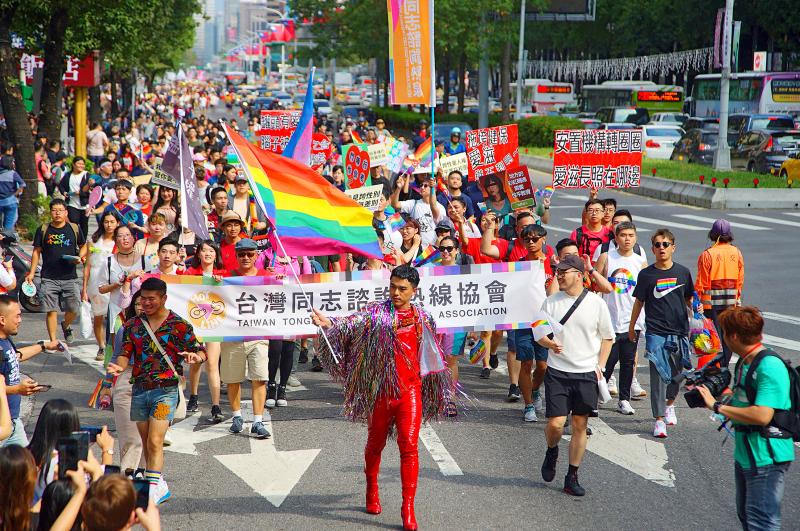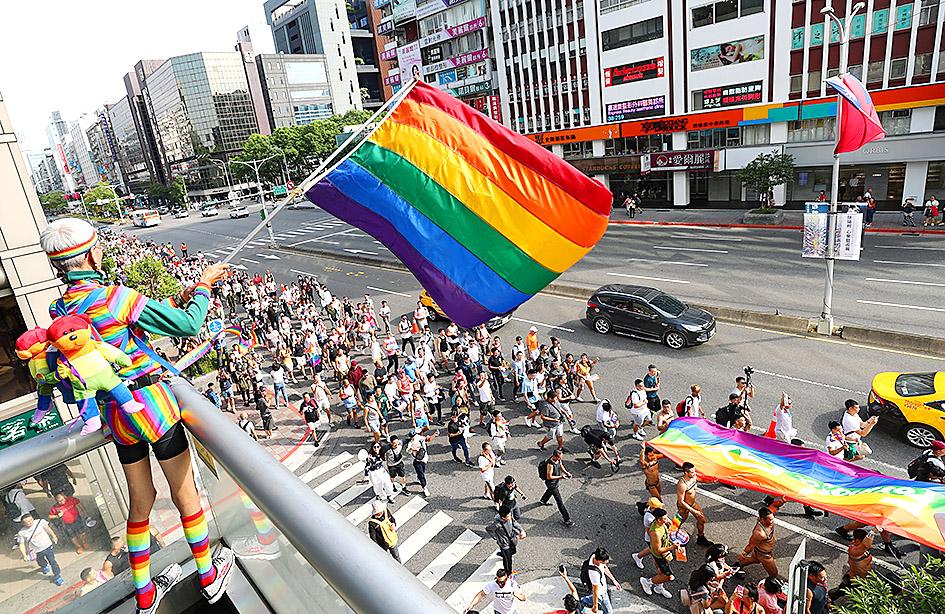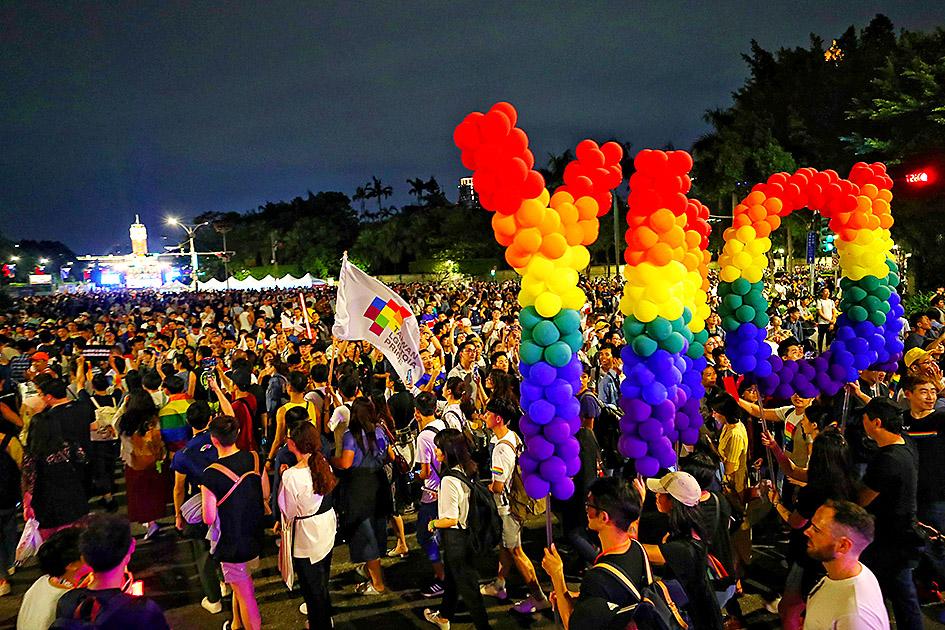Taiwan’s LGBT Pride Parade turns 18 this year.
The movement has come a long way from just wanting to be noticed in 2003 to reaching the milestone of same-sex marriage legalization in 2018, but like humans, coming of age is a major point of departure in one’s life journey.
Taiwan Rainbow Civil Action Association chairperson and parade spokesperson Shao Li-yi (邵立宜) says she is still asked whether a march is needed in this “post same-sex marriage era.”

Photo: CNA
She suggests looking at the 12 co-organizing groups — each one is still working on important issues, from removing HIV stigmas to parents supporting LGBTQ education to assisted sexual relief for disabled people and promoting workplace equality. Even same-sex marriage is far from equal, as issues regarding transnational marriage and adoption are yet to be resolved.
“Even though same-sex marriage has been legalized, these groups have not disappeared,” Shao says. “Neither have the radical anti-LGBTQ groups.”
These issues are all important, but most of all, this year’s parade calls for acceptance and respect toward those who are different, so that everyone can feel encouraged and comfortable to present themselves however they feel fit. The theme of this year’s parade, which begins at 1pm tomorrow at Taipei’s City Hall Plaza, is “Beauty, My Own Way.”

Photos: CNA
“We should be happy that we live in a diverse society — and that includes gender,” Shao says. “Besides feeling comfortable ourselves, we should help other people feel that way too.”
This identity extends to physical beauty as well, which is a problem both inside and outside the LGTBQ community. While beauty standards — especially toward women — are become increasingly homogenized, Shao says there’s also pressure within the gay community, for example, to fit into certain body categories.
Some ask why the LGBTQ community must encompass so many different identities, but according to the parade’s manifesto, this question is problematic since it essentially invalidates how people feel about themselves.

Photo: CNA
“This question confuses the concept of an ‘identity’ with the concept of ‘label,’” it states. “While a label is what we assign to other people, identity is a sense of belonging we grant ourselves ... Nobody can ‘help’ another person decide their identity. Each of us has the right to define what is normal to us based on what is most comfortable to us.”
Shao stresses that this identity can be fluid.
“If three years later I want to grow my hair out and act more feminine, that should be totally fine too,” she says.
Finally, Shao hopes that the parade — which will be livestreamed — can serve as inspiration and comfort for those in countries where parades cannot be held due to COVID-19 as well as those who are suffering from various problems due to being under lockdown.
“We want everyone to know that we are here with you, and you are welcome to join us online,” she says.

As I finally slid into the warm embrace of the hot, clifftop pool, it was a serene moment of reflection. The sound of the river reflected off the cave walls, the white of our camping lights reflected off the dark, shimmering surface of the water, and I reflected on how fortunate I was to be here. After all, the beautiful walk through narrow canyons that had brought us here had been inaccessible for five years — and will be again soon. The day had started at the Huisun Forest Area (惠蓀林場), at the end of Nantou County Route 80, north and east

Specialty sandwiches loaded with the contents of an entire charcuterie board, overflowing with sauces, creams and all manner of creative add-ons, is perhaps one of the biggest global food trends of this year. From London to New York, lines form down the block for mortadella, burrata, pistachio and more stuffed between slices of fresh sourdough, rye or focaccia. To try the trend in Taipei, Munchies Mafia is for sure the spot — could this be the best sandwich in town? Carlos from Spain and Sergio from Mexico opened this spot just seven months ago. The two met working in the

Exceptions to the rule are sometimes revealing. For a brief few years, there was an emerging ideological split between the Democratic Progressive Party (DPP) and Chinese Nationalist Party (KMT) that appeared to be pushing the DPP in a direction that would be considered more liberal, and the KMT more conservative. In the previous column, “The KMT-DPP’s bureaucrat-led developmental state” (Dec. 11, page 12), we examined how Taiwan’s democratic system developed, and how both the two main parties largely accepted a similar consensus on how Taiwan should be run domestically and did not split along the left-right lines more familiar in

A six-episode, behind-the-scenes Disney+ docuseries about Taylor Swift’s Eras Tour and Rian Johnson’s third Knives Out movie, Wake Up Dead Man, are some of the new television, films, music and games headed to a device near you. Also among the streaming offerings worth your time this week: Chip and Joanna Gaines take on a big job revamping a small home in the mountains of Colorado, video gamers can skateboard through hell in Sam Eng’s Skate Story and Rob Reiner gets the band back together for Spinal Tap II: The End Continues. MOVIES ■ Rian Johnson’s third Knives Out movie, Wake Up Dead Man